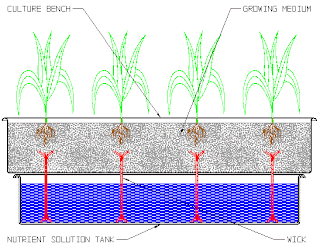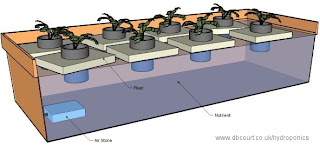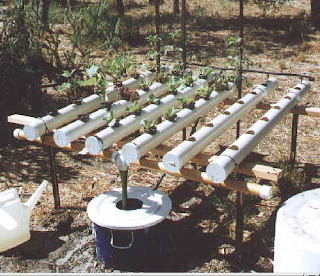If you are planning to grow a hydroponic garden indoors or if you want to extend the growing season for your outdoor garden you will have to use artificial lighting. There are different lights that are for different applications. There are four different types of lighting used for growing plants indoors: High Intensity Discharge, Fluorescent, Incandescent, and LED.
High Intensity Discharge
There are two types of High Intensity Discharge (HID) lights: Metal Halide and High Pressure Sodium.
Metal Halide lights produce an abundance of light in the blue spectrum. This color promotes leafy growth. This is the best primary light if you have no natural light. If you compare metal halide lumen output to incandescent, metal halide lights produce 125 lumens per watt compared to 18 lumens produced by incandescent bulbs. MH lights last for 10,000 cumulative hours.
High Pressure Sodium bulbs produce an orange-red light. This spectrum range produces light that promotes plants to bud and flower. It is best to use the HPS light as a supplementary light source. MH lights are very efficient putting out 140 lumens per watt and they last for 18,000 hours of use.
Fluorescent
Until recently fluorescent lights were only used for growing seedlings. With the advent of full spectrum T5 fluorescent lights more people are using them to grow plants throughout all their life stages. T5 fluorescent lights put out 75 to 90 lumens per watt but they put out much less heat than HID lights so they can be placed closer to the plants so less light is dispersed into the room.
Incandescent
These are the most inexpensive, the least efficient, and a poor source for plant growing light. At best one incandescent light can grow one plant.
LED
LED lights are the latest option for plant growing lights. Testing is still being done despite a lot of producers making very bold claims. They are the most efficient and coolest running lights.
Conclusion
The type of light you use depends on your situation. Are you extending the season of your outdoor garden? Are you sprouting? Are you growing a full fledged hydroponic garden inside?
These are the questions you'll have to answer before you choose the right light for your hydroponic garden.
Monday, July 13, 2009
Hydroponic Gardening Basics
Hydroponics comes from the Greek terms hydro meaning water and ponos meaning labor. The science of hydroponic gardening is nothing new. It's origins have been traced back to the ancient civilizations. There is even research to suggest that one of the seven wonders of the world, the Hanging Gardens, used a hydroponic method for growing food. In recent times the advancements in technology such as high powered indoor lighting, water pumps, new growing mediums, and computer automation have benefited hydroponics. It is now possible for the backyard hobby gardener and the commercial farmer alike to enjoy the benefits of hydroponic gardening.
Hydroponics is the practice of growing plants without the use of soil. This is done by delivering nutrients to the plant roots through a nutrient solution. There are many different techniques for growing hydroponically but they break down into a couple categories: wick, ebb and flow, drip irrigation, and deep water. We'll go into more detail into the different techniques later in the article.
Some people ask, "Why would anyone go through the trouble of setting up a complicated system when they could just plant a seed in the ground and water it?"
It may surprise these people that for many gardeners hydroponics is actually easier. After the initial set up there is no need for pulling weeds because plants are grown in a soil less medium. This is a plus for older people or anyone who can't spend a lot of time bending over pulling weeds and turning soil. Also after the construction of the hydroponic system is complete it is possible for almost total computer automation. This is great for people that have day jobs, other obligations, or just don't want to put so much of their time into growing food but still want to be more self sufficient. Because of the soil less growing medium hydroponics also eliminates the problem of soil born pests and diseases. This cuts down the need for spraying the plants with pesticides. This is good for people that are highly allergic or just don't like the idea of pesticides.
Another benefit for the eco friendly people is that hydroponic gardening uses 1/10th the amount of water than that of the conventional methods because the water in the system recirculates and only has to be changed out occasionally.
Almost any plant that can be grown conventionally can by grown with hydroponics, from lettuce, peppers, tomatoes, squash, squash, cucumbers, and herbs. You can even grow hydroponic strawberries and banana trees.
Wick System
This is a very simple passive irrigation system. The plant is placed in a pot with medium on top of a capillary pad that wicks water up from a reservoir to keep the plant roots and grow medium moist.

Deep Water System
This is a system that commercial lettuce farmers frequently use. This method entails placing plants in floating rafts which are placed directly on top of the water. Roots are fed by growing directly down into the solution.

Ebb and Flow
Sometimes also called Flood and Drain, this is a very popular system with backyard hydroponics. It consists of a water reservoir chamber and the grow beds that are filled with medium. A timer is used to set a pump to fill the grow beds until the water reaches the top of the overflow pipe and then drains back into the solution chamber. This allows for the roots to get nutrients and a good amount of oxygen which is essential to growing plants.

Drip Irrigation
This is a system that is most like conventional planter gardening. A solution reservoir uses a water pump to irrigate the containers through a drip system. The water is then drained from the bottom of the containers back into the reservoir.

Nutrient Film Technology
Plants are grown in net pots that sit in a channel with nutrient solution flowing just as a film at the bottom. The roots of the plants grow to the bottom of the channel and sit in the thin film of flowing water. Since it is just a small film the roots are exposed to nutrients and oxygen at the same time. This technique to popular for growing lettuce.

Conclusion
With ever increasing advancements in technology hydroponic gardening is only going to be more accessible to backyard hobbyists and commercial food producers.
You can also check out this hydroponics for beginners video.
Hydroponics is the practice of growing plants without the use of soil. This is done by delivering nutrients to the plant roots through a nutrient solution. There are many different techniques for growing hydroponically but they break down into a couple categories: wick, ebb and flow, drip irrigation, and deep water. We'll go into more detail into the different techniques later in the article.
Some people ask, "Why would anyone go through the trouble of setting up a complicated system when they could just plant a seed in the ground and water it?"
It may surprise these people that for many gardeners hydroponics is actually easier. After the initial set up there is no need for pulling weeds because plants are grown in a soil less medium. This is a plus for older people or anyone who can't spend a lot of time bending over pulling weeds and turning soil. Also after the construction of the hydroponic system is complete it is possible for almost total computer automation. This is great for people that have day jobs, other obligations, or just don't want to put so much of their time into growing food but still want to be more self sufficient. Because of the soil less growing medium hydroponics also eliminates the problem of soil born pests and diseases. This cuts down the need for spraying the plants with pesticides. This is good for people that are highly allergic or just don't like the idea of pesticides.
Another benefit for the eco friendly people is that hydroponic gardening uses 1/10th the amount of water than that of the conventional methods because the water in the system recirculates and only has to be changed out occasionally.
Almost any plant that can be grown conventionally can by grown with hydroponics, from lettuce, peppers, tomatoes, squash, squash, cucumbers, and herbs. You can even grow hydroponic strawberries and banana trees.
Wick System
This is a very simple passive irrigation system. The plant is placed in a pot with medium on top of a capillary pad that wicks water up from a reservoir to keep the plant roots and grow medium moist.

Deep Water System
This is a system that commercial lettuce farmers frequently use. This method entails placing plants in floating rafts which are placed directly on top of the water. Roots are fed by growing directly down into the solution.

Ebb and Flow
Sometimes also called Flood and Drain, this is a very popular system with backyard hydroponics. It consists of a water reservoir chamber and the grow beds that are filled with medium. A timer is used to set a pump to fill the grow beds until the water reaches the top of the overflow pipe and then drains back into the solution chamber. This allows for the roots to get nutrients and a good amount of oxygen which is essential to growing plants.

Drip Irrigation
This is a system that is most like conventional planter gardening. A solution reservoir uses a water pump to irrigate the containers through a drip system. The water is then drained from the bottom of the containers back into the reservoir.

Nutrient Film Technology
Plants are grown in net pots that sit in a channel with nutrient solution flowing just as a film at the bottom. The roots of the plants grow to the bottom of the channel and sit in the thin film of flowing water. Since it is just a small film the roots are exposed to nutrients and oxygen at the same time. This technique to popular for growing lettuce.

Conclusion
With ever increasing advancements in technology hydroponic gardening is only going to be more accessible to backyard hobbyists and commercial food producers.
You can also check out this hydroponics for beginners video.
Sunday, July 12, 2009
Video of Hydroponic System for Beginners
This video shows how to set up a simple deep water culture hydroponics system. If you are just starting out in the world of hydroponics this is a good first set up to get some experience with. Once you have some experience with this system you could easily move up to a flood and drain system.
From the video you can see that hydroponics is not as complicated as most people think. It can get complicated when you get to the commercial scale with computer automation but if you are just starting out it is possible to build you own system for not a lot of money and be up and running within a couple days.
The difference between the deep water culture and a flood and drain is a reservoir for the nutrient solution, a water pump, and a timer. You could actually take a system similar to the one in the video and convert it into a flood and drain hydroponic system when you feel comfortable with your new hobby.
So spend some time on starting a plant from a seed in a soil grow tray, cleaning all the dirt off the roots, transplanting the seedling into a net pot filled with your grow medium, and actually producing fruit. This will show you if you actually want to invest some real time and money into hydroponics. It will also give you the experience and confidence you'll need to
From the video you can see that hydroponics is not as complicated as most people think. It can get complicated when you get to the commercial scale with computer automation but if you are just starting out it is possible to build you own system for not a lot of money and be up and running within a couple days.
The difference between the deep water culture and a flood and drain is a reservoir for the nutrient solution, a water pump, and a timer. You could actually take a system similar to the one in the video and convert it into a flood and drain hydroponic system when you feel comfortable with your new hobby.
So spend some time on starting a plant from a seed in a soil grow tray, cleaning all the dirt off the roots, transplanting the seedling into a net pot filled with your grow medium, and actually producing fruit. This will show you if you actually want to invest some real time and money into hydroponics. It will also give you the experience and confidence you'll need to
Subscribe to:
Posts (Atom)